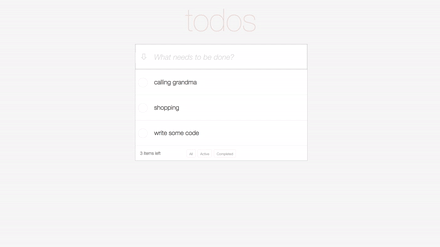Realtime ToDo List
Learn how to create a realtime ToDo list using deepstream technology
Help needed to update and migrate to Guides Section
You probably know the TodoMVC project (if not, take a look). We believe that deepstream’s lists and records can simplify the development and implementation of many kinds of project, ToDomvc and the like are good examples for that. This tutorial will show you how to use deepstream’s records and lists for building a realtime TodoList app with React. We definitely recommend being familiar with Records and Lists before giving this a go, and, of course, with the React framework.
This is how it looks like:

Connect to deepstream and log in
Include the JS-client library
<script src="https://cdn.deepstream.io/js/client/latest/ds.min.js"></script>Get your app url from the dashboard and establish a connection to deepstream
const dsClient = new DeepstreamClient('localhost:6020');and log in (we didn’t configure any authentication, so there are no credentials required)
ds.login();Getting the list and subscribing for updates
Include this in your main component’s constructor/getInitialState section:
this.list = ds.record.getList( 'todos' );
this.list.subscribe(this._setEntries.bind( this ) );Then set the setEntries function that keeps listening to changes in the list (new entry, removed entry):
_setEntries( entries ) {
this.setState({
todos: entries
});
}This.state.todos is an array of record names (entries) retrieved from the list. Now, with this binding, each time a todo item is added or removed, the state of the component is automatically updated. Each todo item is rendered separately in a different component, being passed a recordName. Every time the TodoItem component is initiated, it uses the recordName to get the details from the actual record. This is what should be included in the TodoItem’s constructor/getInitialState section:
this.record = ds.record.getRecord(this.props.recordName);
this.record.subscribe(this.setState.bind(this), true);In that way, first of all, all the data of the record is being retrieved, in this case - the title and the isDone, passed to the state of the component, and rendered. Then, each time there’s an update in the record, for example the title is edited, the state of the element is automatically updated (after updating the record), and the component re-rendered.
Adding/removing/updating ToDo items
Whenever a text is being entered in the input field, two things should happen - a record should be initiated, and the list should get a new entry. This is the function that’s being called when a new Todo is in:
addTodo() {
const id = 'todo/' + ds.getUid();
ds.record.getRecord(id).set({
title: this.state.newTodo,
isDone: false
});
this.list.addEntry( id );
}As you can see, first a unique id is being created, then a record is being created with the unique id name, the title from the input field, and a default ‘isDone’ property that is being set to ‘false’. Also, an entry is being added to the list, which automatically sets the state, which makes the whole thing render again with the new record. When the delete button is being pressed, a function like this should be invoked:
removeTodo() {
this.props.list.removeEntry( this.record.name );
this.record.delete();
}To update a record, for example the title, use this:
this.record.set('title', title);In case all the checkboxes are checked, and the “Clear Completed” button is being pressed, this how you would empty the whole list:
list.setEntries([]);For the full code, please take a look at the GitHub repository.